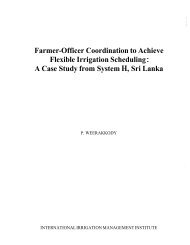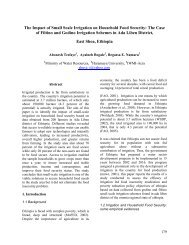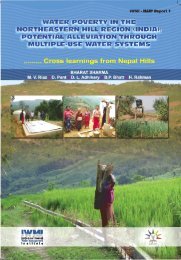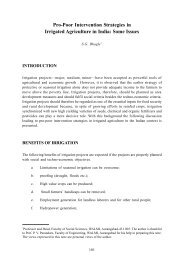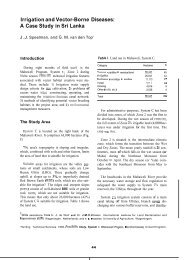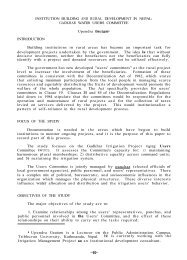David Molden, R Sakthivadivel and M Samad - International Water ...
David Molden, R Sakthivadivel and M Samad - International Water ...
David Molden, R Sakthivadivel and M Samad - International Water ...
You also want an ePaper? Increase the reach of your titles
YUMPU automatically turns print PDFs into web optimized ePapers that Google loves.
<strong>Molden</strong>, <strong>Sakthivadivel</strong> <strong>and</strong> <strong>Samad</strong>: Accounting for Changes in <strong>Water</strong> Use<br />
not fit the dem<strong>and</strong>s of the poor. Are the voices of disadvantaged people heard when<br />
making management decisions? During the allocation phase, water is reallocated<br />
amongst sectors <strong>and</strong> people. When water moves away from agriculture to cities <strong>and</strong><br />
industries, will the poor <strong>and</strong> less powerful be able to maintain their right to water; or<br />
capture the economic gains when water moves to higher valued uses?<br />
Environmental concerns also change over time. During development stages, huge<br />
changes in nature can take place. During the utilisation phase, water use <strong>and</strong><br />
depletion intensifies, further removing water that has environmental functions. A<br />
solution to scarCity is to tap into natural heritage sites for more water, resulting<br />
in damaged wetl<strong>and</strong>s. During early phases of development, dilution can be<br />
sufficient to' solve pollution problems. During allocation phases, dilution is not an<br />
option, because there simply is not enough water. Clean-up at the source<br />
becomes increasingly critical.<br />
In the allocation phase, a host of potential problems exist: pollution, conflict<br />
management, resource overdraft. Managing more <strong>and</strong> different types of<br />
information becomes increasingly important. Information needs at the<br />
development phase are different. For design, information on river flows to assess<br />
supply, <strong>and</strong> climate <strong>and</strong> population to assess dem<strong>and</strong>s are necessary. During<br />
the utilisation phase, more information is needed on the delivery of water services.<br />
6. Adaptive Institutions<br />
If early in the development phase, we try to design an institutional framework<br />
that deals with all these issues-pollution, poverty, allocation, regulation,<br />
construction-it is likely that we would fail. At certain phases of development,<br />
some of these are not major concerns. It is probably right that there are<br />
construction agencies to make sure that there is safe <strong>and</strong> sound construction. It<br />
is probably not right that the same institutional set-up is used to manage service<br />
delivery. A different set of rules is required, different skills are required. And those<br />
who manage service delivery are probably not appropriate to regulate allocation<br />
<strong>and</strong> pollution of resources when these problems emerge.<br />
The implication is that water resource management institutions must adapt to<br />
meet different challenges as patterns of water use change. Common water<br />
problems are seen because agencies, at one time competent to carry out tasks,<br />
do not change. When evaluating an institution, we may find that they do 7 out of<br />
10 tasks fairly well. The seven may not be so important, while the three missing<br />
ones, may be critical. When analysing institutions then, we need to underst<strong>and</strong><br />
the mechanisms that exist to adapt to change. Are there rules to change rules?<br />
7. Examples<br />
Let us explore two examples-one taken from Nepal, <strong>and</strong> one from China to<br />
illustrate these concepts. The water accounting finger diagrams are given in Figure<br />
2, The Nepalese example illustrates a case of a basin in the development phase,<br />
while the Chinese basin is closed, <strong>and</strong> is clearly in an allocation phase. Basic<br />
information on the two basins is presented in Table 2.<br />
80



